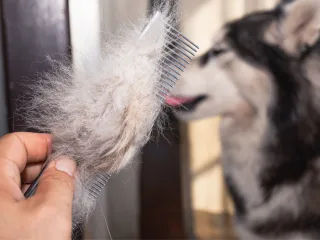-
×
 PATE CAT 190GR - TUNA 1 × 1 $
PATE CAT 190GR - TUNA 1 × 1 $ -
×
 LUCKY FISH FEED 100G 1 × 1 $
LUCKY FISH FEED 100G 1 × 1 $
Handbook
5 Tips for Grooming “Difficult”, Aggressive Dogs
Brushing Your Dog’s Fur: Gentle Tips for Stubborn Pets
Brushing is one of the most basic yet crucial steps to keeping a dog’s coat clean, shiny, and healthy. However, if you’re raising a “stubborn” dog who growls or gets aggressive whenever the brush comes out, this task can quickly become a real challenge.
So, how can you brush your furry friend in a gentle, effective way without causing them stress or resistance? Let’s explore together with Pro-Pet in the article below!
1. Why Do Dogs Get Aggressive or Irritated When Being Brushed?
Before you look for solutions, it’s important to understand why your dog feels uncomfortable with brushing. Here are the most common reasons behind this reaction:
1.1. Negative Past Experiences
Just like humans, dogs have memory and emotions. If they’ve previously experienced pain during brushing—such as hair being pulled too hard or getting tangled in the comb—they may develop a fear. Scolding or punishing them during grooming can also create a negative association, making them wary, aggressive, or likely to flee.
1.2. Inherent Personality Traits
Not every dog enjoys being pampered. Each one has a distinct personality: some are gentle and cooperative, while others are independent and dislike too much physical contact. Certain sensitive breeds may also react more intensely to changes or touch.
/27.png)
1.3. Health Issues
If your dog is in pain—for instance, due to injuries, arthritis, or skin conditions like fungal infections, dermatitis, or mange—brushing may feel especially uncomfortable. When you unknowingly touch a sensitive area, your dog might react by growling, barking, or even giving a warning bite to defend themselves.
2. Tip #1: Create a Relaxing and Safe Grooming Space
The first step is to make brushing a pleasant experience. Choose a quiet space, away from loud noises or heavy foot traffic. Lay down a soft mat for comfort, then prepare all necessary tools such as brushes, towels, and a detangling spray (if available).
Before you start brushing, try petting your dog or scratching spots they enjoy, like the neck or belly. This helps them feel loved and more likely to cooperate.
3. Tip #2: Gradually Introduce the Brush
Don’t rush the process. If your dog isn’t used to brushing, it’s perfectly normal. Leave the brush near their resting area so they can sniff and get used to it. You can also rub the brush on your hand or gently stroke areas like the back or hips, which are less sensitive.
/25.png)
Note: Always use a brush suited for your dog’s coat type (long, short, curly…) to avoid causing pain.
4. Tip #3: Brush Slowly, Gently, and With Proper Technique
Start brushing from less sensitive areas like the back or hindquarters, then slowly move to other parts. Avoid using too much force, as this can cause hair breakage or pain. If you encounter tangles, patiently work through them instead of yanking.
If your dog becomes anxious or growls, pause the session. Talk to them in a soothing voice and pet them to calm them down before resuming.
5. Tip #4: Use Rewards and Discipline Appropriately
Dogs respond well to rewards, so always have some treats or their favorite snack ready when they allow brushing without resistance. This creates a positive association with grooming.
If they act out or run away, avoid yelling or punishing them. This will only increase their fear. Instead, show disapproval by withdrawing attention—turn away or pause playtime for a few minutes so they understand the behavior isn’t acceptable.
6. Tip #5: Use Calming Scents
A great way to help your dog relax during brushing is by using natural essential oils like lavender or chamomile. These scents help soothe the nervous system and reduce stress.
/24.png)
However, always dilute essential oils with warm water before lightly spraying on their fur or bedding. Ensure the oils are safe for pets and don’t irritate the skin. It’s best to consult your vet before using any scented product on your dog.
Final Thoughts: Patience Is the Golden Key
Brushing is not just about grooming—it’s also a way to bond with your dog. If your dog is “high-maintenance,” don’t be discouraged. With understanding, proper techniques, and patience, your dog will gradually get used to (and maybe even enjoy!) grooming time.

 PATE CAT 190GR - TUNA
PATE CAT 190GR - TUNA  LUCKY FISH FEED 100G
LUCKY FISH FEED 100G 